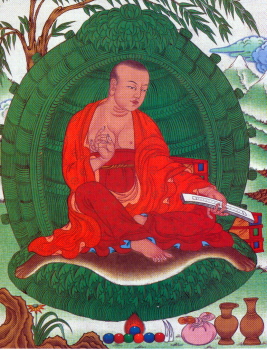 |
|  |
Cilupa |
Piṇḍo Ācārya |
 |
|  |
Cilupa |
Piṇḍo Ācārya |
|
Below there follows a brief introduction to the history of Kālacakra. Tāranātha's history – click here for the history of Kālacakra in Sambhala and India, according to the Jonang writer, Tāranātha. History according to Amye Zhab – click here for the history of Kālacakra in India according to the Sakya writer, Amye Zhab.
Introduction to the history of Kālacakra.The history of the Kālacakra tradition is complex. Back in the 13th century, the first native Tibetan text on the perfection process meditation of Kālacakra was written by the Jonang master Kunpangpa (kun spangs pa), who lived from 1243-1313. He collated the different traditions existing in Tibet at the time, and identified 17 distinct traditions of the six yogas.In addition to this there were many traditions of other aspects of Kālacakra: the generation process meditations, the initiations, the theory (explanations of the tantra, etc), astronomy and astrology, and so forth. All of these traditions had come from the variety of lineages in northern India, had been translated into Tibetan by various translators, and found their way into the different schools in Tibet. To describe the history fully would therefore be very complex, but all these traditions share a common origin in the early teachings as they emerged in India, apparantly from the mysterious land of Sambhala. These traditions were then transfered to Tibet, starting in the early 11th century. All the stories relate that the Buddha taught the Kālacakra Mūlatantra to Sucandra, king of Sambhala, at the great stupa of Dhānyakaṭaka, in Amaravati. These teachings were preserved in that land until approximately the 10th century, when contact between one of Sucandra's successors and an Indian master (very often named as Cilupa or Piṇḍo Ācārya, see the images above) saw the adoption of Kālacakra in India. Three or four generations later, various Indians and Nepalis helped with the translation of many Sanskrit works on Kālacakra into Tibetan. The Blue Annals gives a list of twenty translators who translated the Kālacakra Tantra alone, but it is generally accepted that two translators stand out as pre-eminent: Dro Sherab Drak ('bro shes rab grags), born at the beginning of the 11th century, who worked mainly with the Kashmiri Somanātha, and Rwa Chorab (rwa chos rab), born in the middle of the 11th century. He travelled to Nepal and worked with the Newari paṇḍita Samantaśrī, who lived in Patan, just south of Kathmandu.
For example, in a quote often cited from The Blue Annals, Zhonnu Pal ('gos lo tsā ba gzhon nu dpal) writes of two contemporary (14th century) great Tibetan masters of Kālacakra, Buton Rinchen Drup (bu ston rin chen grub) and Dolpopa Sherab Gyaltsen (dol po pa shes rab rgyal mtshan). In Roerich's translation (p. 755) of The Blue Annals, we read: "Bu(ston) and Dol-(pa-pa) were the two great expounders of the Kālacakra in the Land of the Snows. These two first obtained it from the spiritual descendants of Rwalo-(tsā-ba), but later they studied it according to the tradition of 'Bro lo-tsā-ba." Buton had considerable influence on the later development of the Gelug and Sakya traditions of Kālacakra, and Dolpopa on the development of the Jonang, but there were many other influences and much cross-fertilisation between the different traditions. At present on this site there are two extracts from Tibetan historical works. The first is by the Jonang writer Tāranātha, and this extract covers the stories of the Kālacakra tradition in Sambhala and India, according to the Dro tradition. The second also covers the the Dro tradition account from the very extensive Kālacakra history written by the Sakya Amye Zhab (a mye zhabs, or, ngag dbang kun dga' bsod nams). It is intended that further material will be made available later.
|